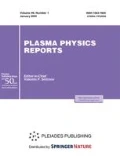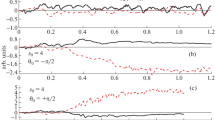Abstract
The dynamics of turbulent edge plasma in the T-10 tokamak is simulated numerically by solving reduced nonlinear MHD equations of Braginskii’s two-fluid hydrodynamics. It is shown that the poloidal plasma velocity is determined by the combined effect of two forces: the turbulent Reynolds force FR and the Stringer–Winsor geodesic force FSW, which is associated with the geodesic acoustic mode of the total plasma pressure \(\left\langle {p{\text{sin}}\theta } \right\rangle \). It follows from the simulation results that the FR and FSW forces are directed oppositely and partially balance one another. It is shown that, as the electron temperature increases, the resulting balance of these forces changes in such a way that the amplitude of the poloidal ion flow velocity and, accordingly, the electrostatic potential \({{\phi }_{0}}(r,t)\) decrease. As the plasma density increases, the “driving forces” of turbulence (the dn0/dr and dp0/dr gradients) also increase, while dissipation due to the longitudinal current decreases, which results in an increase in the amplitude of turbulent fluctuations and the Reynolds force FR. On one hand, the force FSW increases with increasing plasma density due to an increase in the pressure \(\left\langle {p{\text{sin}}\theta } \right\rangle \); however, on the other hand, it decreases in view of the factor 1/n0. As a result, the net force driving poloidal rotation increases, which leads to the growth of the plasma potential. Both under electron-cyclotron resonance heating and in regimes with evolving plasma density, the results of numerical simulations qualitatively agree with experimental data on the electrostatic potential of the T-10 plasma.










Similar content being viewed by others
REFERENCES
A. V. Melnikov, Electric Potential in Plasmas of Toroidal Devices (NIYaU MIFI, Moscow, 2015) [in Russian].
F. Wagner, Plasma Phys. Controlled Fusion 49, B1 (2007).
T. Viezzer, G. D. Putterich, R. Conway, R. Dux, T. Happel, J. C. Fuchs, R. M. McDermott, F. Ryter, B. Sieglin,W. Suttrop1, M. Willensdorfer, E. Wolfrum, and the ASDEX Upgrade Team, Nucl. Fusion 53, 053005 (2013).
A. V. Melnikov, V. A. Vershkov, and S. A. Grashin, in Proceedings of the 37th EPS Conference on Plasma Physics, Dublin, 2010, ECA 34A, O5.1280 (2010).
A. V. Melnikov, L. G. Eliseev, S. V. Perfilov, V. F. Andreev, S. A. Grashin, K. S. Dyabilin, A. N. Chudnovskiy, M. Yu. Isaev, S. E. Lysenko, V. A. Mavrin, M. I. Mikhailov, D. V. Ryzhakov, R. V. Shurygin, and V. N. Zenin, Nucl. Fusion 53, 093019 (2013).
A. N. Simakov and P. J. Catto, Phys. Plasmas 10, 4744 (2003).
A. Zeiler, J. F. Drake, and B. Rogers, Phys. Plasmas 4, 2134 (1997).
R. V. Shurygin and D. Kh. Morozov, Plasma Phys. Rep. 40, 919 (2014).
R. V. Shurygin and A. A. Mavrin, Plasma Phys. Rep. 36, 535 (2010).
O. E. Garsia, N. H. Bian, and W. Fundamenski, Phys. Plasmas 13, 082309 (2006).
P. N. Guzdar and A. B. Hassam, Phys. Plasmas 3, 3701 (1996).
R. V. Shurygin and A. V. Melnikov, Plasma Phys. Rep. 44, 303 (2018).
D. R. McCarthy, J. F. Drake, P. N. Guzdar, and A. B. Hassam, Phys. Fluids 4, 1188 (1993).
N. Miyato, J. Li, and Y. Kishimoto, Nucl. Fusion 45, 425 (2006).
V. A. Rozhansky, S. P. Voskoboynikov, E. G. Kaveeva, D. P. Coster, and R. Schneider, Nucl. Fusion 41, 387 (2001).
V. A. Rozhansky, S. P. Voskoboynikov, E. G. Kaveeva, D. P. Coster, X. Bonnin, and R. Schneider, Nucl. Fusion 43, 614 (2003).
V. Rozhansky, Contrib. Plasma Phys. 46, 575 (2006).
T. D. Rognlien, D. D. Ryutov, N. Mattor, and C. D. Porter, Phys. Plasmas 6, 1851 (1999).
A. V. Melnikov, L. I. Krupnik, L. G. Eliseev, J. M. Barcala, A. Bravo, A. A. Chmyga, G. N. Deshko, M. A. Drabinskij, C. Hidalgo, P. O. Khabanov, S. M. Khrebtov, N. K. Kharchev, A. D. Komarov, A. S. Kozachek, J. Lopez, et al., Nucl. Fusion 57, 072004 (2017).
A. V. Melnikov, L. I. Krupnik, E. Ascasibar, A. Cappa, A. A. Chmyga, G. N. Deshko, M. A. Drabinskij, L. G. Eliseev, C. Hidalgo, P. O. Khabanov, S. M. Khrebtov, N. K. Kharchev, A. D. Komarov, A. S. Kozachek, S. E. Lysenko, et al., Plasma Phys. Controlled Fusion 60, 084008 (2018).
ACKNOWLEDGMENTS
This work was supported by the Russian Foundation for Basic Research, project no. 14-22-00193. A.V. Melnikov acknowledges the support from the National Research Nuclear University “MEPHI.”
Author information
Authors and Affiliations
Corresponding author
Additional information
Translated by I. Grishina
APPENDIX
APPENDIX
Most experimental data concern plasma parameters averaged over the poloidal angle, \({{f}_{0}}(r,t) = \)\({{\left\langle {f(r,\theta ,t)} \right\rangle }_{\theta }}\). It is useful to derive separate equations for the time evolution of the variables f0 = {\({{V}_{0}},{{n}_{0}},{{p}_{{e,i\,0}}},{{V}_{{||0}}}\)} by using the expansion \(f(r,\theta ,t) = {{f}_{0}}(r,t) + \tilde {f}(r,\theta ,t)\), where \({{f}_{0}} = \left\langle f \right\rangle = {{\left( {2\pi } \right)}^{{ - 1}}}\int_0^{2\pi } {fd\theta } \). After averaging the equations presented in Section 2, we obtain the following equations for the averaged variables:
Set of equations (A.1)–(A.4) should be supplemented with Eq. (8) for the poloidal velocity V0(r, t). When solving set of equations (A.1)–(A.4), the following boundary conditions were used:
Turbulent fluxes of the momentum, particles, and heat are calculated as sums of the fluxes of axisymmetric (fA) and ballooning (fB) modes,
We note that the main contribution to the transport is made by the fluxes \({{\Pi }_{B}}\), \({{\Gamma }_{B}}\), and \({{Q}_{{Bj}}}\) (\(j = e,i\)), which are associated with ballooning modes. The set of equations for the ballooning modes fBS,BC = {WBS,BC, \({{n}_{{BS,BC}}}\), \({{p}_{{e\,BS,BC}}}\)} in the case of pi = τpe is presented in [12].
Rights and permissions
About this article
Cite this article
Shurygin, R.V., Melnikov, A.V. Electric Field and Poloidal Rotation in the Turbulent Edge Plasma of the T-10 Tokamak. Plasma Phys. Rep. 45, 220–229 (2019). https://doi.org/10.1134/S1063780X19020107
Received:
Revised:
Accepted:
Published:
Issue Date:
DOI: https://doi.org/10.1134/S1063780X19020107




